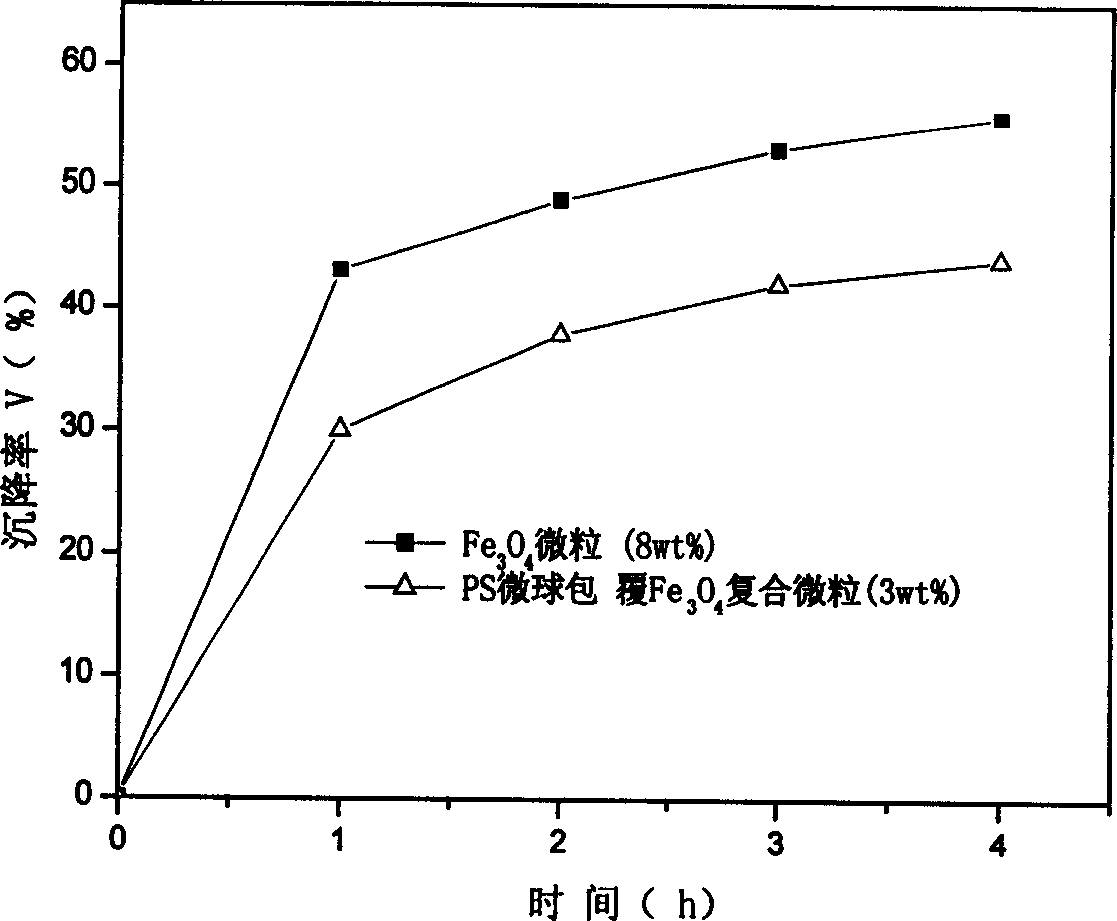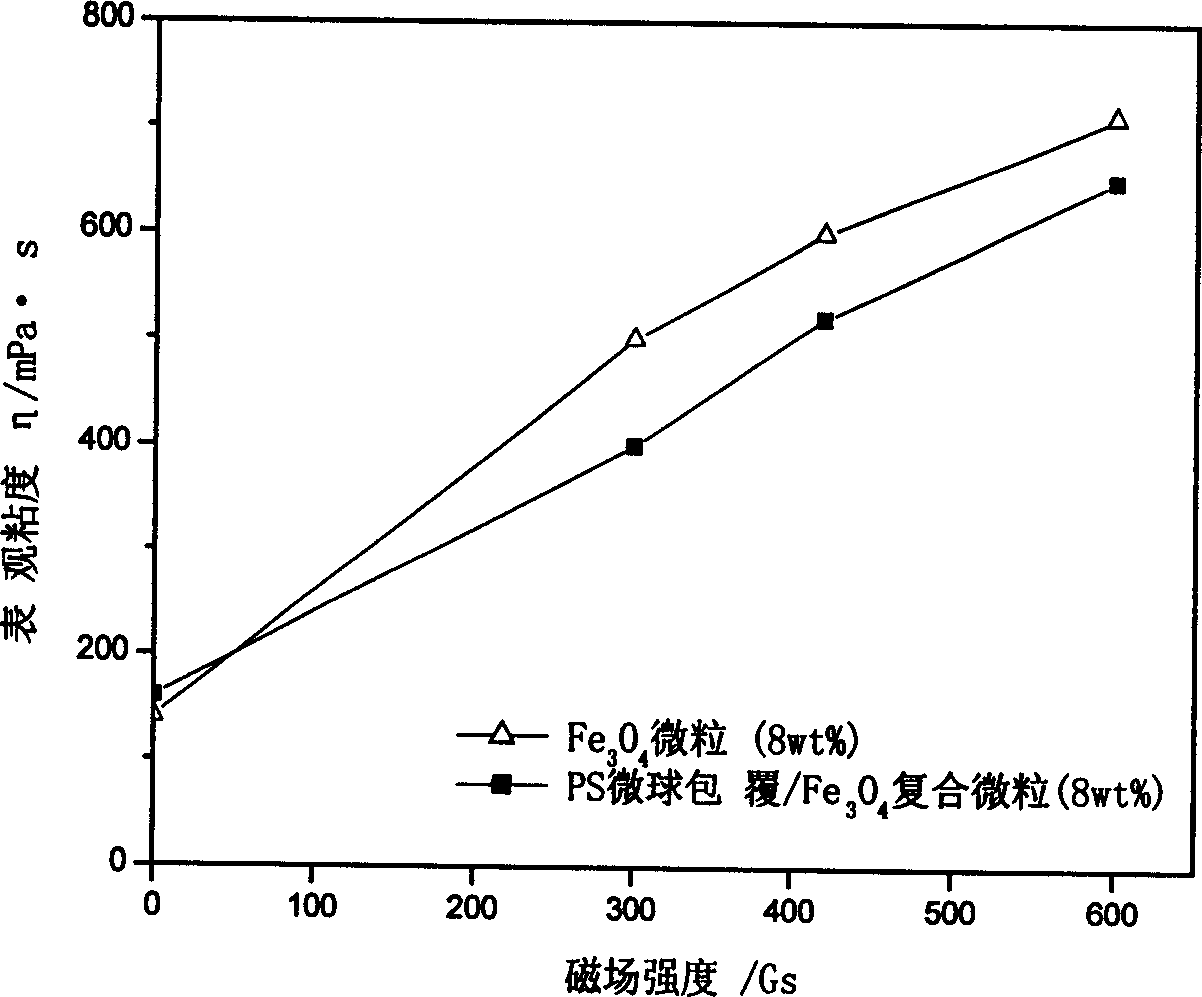Method for preparing hollow magnetic composite particulate for magnetic rheologic liquid by using polystyrene microsphere
A technology of composite particles and magnetorheological fluids, which is applied in the field of composite materials and functional materials, can solve problems affecting the performance and popularization of magnetorheological fluids, easy sedimentation, high density, etc., and achieve excellent sedimentation stability, shear High stress and good magnetic properties
- Summary
- Abstract
- Description
- Claims
- Application Information
AI Technical Summary
Problems solved by technology
Method used
Image
Examples
Embodiment 1
[0029] The ratio of raw materials used is as follows:
[0030] Hollow PS microspheres (average particle diameter 2.5μm) 100 parts (weight)
[0031] Sodium lauryl sulfate 5 parts (weight)
[0032] 100 parts (weight) of ferric chloride
[0033] 50 parts (weight) of ferrous sulfate heptahydrate
[0034] 50 parts (weight) of sodium hydroxide
[0035] Preparation of magnetic composite particles:
[0036] According to the proportion of the above components, the hollow PS microspheres were ultrasonically dispersed in deionized water for 3 hours to obtain sample a. Make a solution of ferric chloride and ferrous sulfate heptahydrate into the reaction vessel, add sample a, stir and heat for 0.5-1 hour, and raise the temperature to 60°C; dissolve NaOH in deionized water to form a solution, and add it to the reaction vessel After stirring for 1 hour, continue to heat up to 90°C, stop heating, add sodium lauryl sulfate, and cool under st...
Embodiment 2
[0042] The proportioning of used raw materials by weight share is as follows:
[0043] Hollow PS microspheres (average particle size 50nm) 100 parts
[0044] Sodium Lauryl Sulfate 0 parts
[0045] Fe(NO 3 ) 3 50 copies
[0046] FeSO 4 20 copies
[0047] Sodium hydroxide 20 parts
[0048] Preparation of magnetic composite particles:
[0049] According to the proportion of the above components, the hollow PS microspheres were ultrasonically dispersed in deionized water for 2 hours to obtain sample a. Fe(NO 3 ) 3 and FeSO 4 Make a solution and add it to the reaction vessel, add sample a, stir and heat for about 1 hour, and then raise the temperature to 65°C; dissolve NaOH in deionized water to make a solution, add it to the reaction vessel, stir and react for 1.5 hours, then continue to heat up to 95°C , stop heating, and cool under stirring. Wash with deionized water until neutra...
Embodiment 3
[0051]The proportioning of used raw materials by weight share is as follows:
[0052] Hollow PS microspheres (average particle diameter 20μm) 100 parts (weight)
[0053] Sodium lauryl sulfate 50 parts (weight)
[0054] Fe 2 (SO 4 ) 3 400 parts (weight)
[0055] FeCl 2 200 parts (weight)
[0056] NH 3 h 2 O 200 parts (weight)
[0057] Preparation of magnetic composite particles:
[0058] The hollow PS microspheres were ultrasonically dispersed in deionized water for 5 hours to obtain sample a. Will Fe 2 (SO 4 ) 3 and FeCl 2 Prepare a solution and add it to a reaction vessel, add sample a, stir and heat for 1-1.5 hours, and raise the temperature to 55°C; add NH 3 h 2 O was dissolved in deionized water to make a solution, added to the reaction vessel and stirred for 1 hour, then continued to heat up to 100°C, stopped heating, added sodium lauryl sulfate, and cooled under stirring. Wash w...
PUM
| Property | Measurement | Unit |
|---|---|---|
| The average particle size | aaaaa | aaaaa |
| Apparent density | aaaaa | aaaaa |
| Particle size | aaaaa | aaaaa |
Abstract
Description
Claims
Application Information
 Login to View More
Login to View More - R&D
- Intellectual Property
- Life Sciences
- Materials
- Tech Scout
- Unparalleled Data Quality
- Higher Quality Content
- 60% Fewer Hallucinations
Browse by: Latest US Patents, China's latest patents, Technical Efficacy Thesaurus, Application Domain, Technology Topic, Popular Technical Reports.
© 2025 PatSnap. All rights reserved.Legal|Privacy policy|Modern Slavery Act Transparency Statement|Sitemap|About US| Contact US: help@patsnap.com


